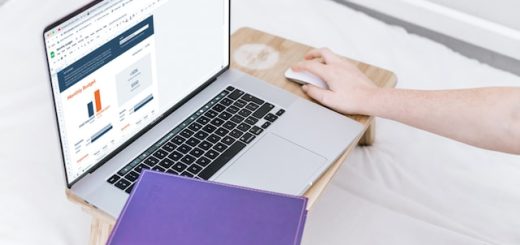How I Earn a Living as a Blogger from Digital Photography School

This post is based on episode 150 of the ProBlogger podcast.
One of our main aims here at ProBlogger is to help people make money (if not a living) from their blogs. And we’ve certainly talked about it a lot over the years. We even have a portal dedicated to this very topic.
But this week I’d like to give you some concrete examples by telling you how I earn a living from ProBlogger and Digital Photography School.
Now before I get into the details, I need to tell you a few things.
Firstly, this information is based on ProBlogger and Digital Photography School (dPS) combined. Of course, seeing as dPS is about eight times the size of ProBlogger that’s where the bulk of the profit comes from. But these figures (or rather percentages) are for the entire business.
Secondly, I’ll be talking about profit, not revenue. They are two very different things, and talking about revenue without mentioning expenses isn’t very useful. Spending a thousand dollars to make a thousand dollars won’t get you very far.
Finally, I’ll be talking about percentages rather than actual amounts because talking about what I earn makes me feel a little uncomfortable. And depending on what stage you’re at on your blogging journey, the percentages will be far easier to relate to.
So, with that out of the way let me tell you how I earn a living as a blogger.
1. Affiliate commissions
Nearly half of my income (46%) comes from affiliate commissions. Around 10% of those commissions are from Amazon, with the rest distributed among eBooks, courses, software and online services.
The great thing about commissions is there are no expenses (other than the time it takes to set them up), and so you can keep whatever you earn.
2. Product sales
My second-largest income earner is product sales at 31%.
Remember how I said it was important to look at profits rather than revenue? I earn pretty much the same revenue from product sales as I do from affiliate commissions. But the eBooks, Lightroom presets, courses and printables I sell don’t just appear out of thin air. People put time and effort into creating them. And we pay them for their time and effort, which reduces our profits.
3. AdSense revenue
My third-highest income stream (8%) comes via Google’s AdSense program.
This was the first income stream I ever tried (somewhere around 2003–2004), and it still works for me. I don’t have to split the money with anyone, and because AdSense has already taken its cut there aren’t too many direct expenses.
Of course, that doesn’t mean it will work for every blogger and every type of blog. Digital Photography School gets four to five million visitors a month, which really helps with banner ads. AdSense seems to like our site as well.
And I should also point out that our AdSense income isn’t what it used to be. Some of that has to do with the direct sponsorship we’ve managed to secure. But even if we ignore that fact for a moment, AdSense’s earnings have been slowly declining over the past few years.
And it’s not just us. Most people who use AdSense or other ad networks have seen similar declines in income. And a lot of the ad networks are now developing different products because their revenue is slipping.
AdSense makes up about 8% of our total income. That sounds small but it’s fairly significant. It’s certainly a nice direct deposit to get in my bank account every month. It doesn’t go up and down a lot. It just really depends on traffic. As I said, slowly declining as well.
4. Sponsorships
Next at 6% is sponsorships (i.e. working directly with brands).
I started doing this around 2004–2005. I can still remember ringing a camera store for the first time and saying, “Hey, would you like to reach people looking to buy cameras? Because I’ve got a photography blog”.
Of course, I then had to explain what a blog actually was. But I eventually convinced a camera store to pay me $20 a month to advertise on my blog. And as my traffic increased I’d would raise the monthly amount accordingly.
On Digital Photography School we offer sponsorship options to advertisers, and replace AdSense with their ads. But we’ll only do it if we’d earn more from the sponsorship deal than we would from AdSense. (We know how much an AdSense slot will earn us, and so we try to at least double the amount from a direct sponsorship ad campaign.
So far we’ve had sponsorship from:
- Canon and Tamron
- other photography education sites
- centers such as the New York Institute of Photography.
We also offer:
- placements in our newsletter (which goes out to about 700,000 readers every month)
- opportunities to run competitions on the site
- social media advertising (which we always disclose).
We haven’t used banner advertising or AdSense much on ProBlogger. But we have done a few sponsorships campaigns on the podcast and at events. In fact, the profit we make at events comes mostly from the sponsors.
(I’ve put the money we make from events in a separate category that I’ll get to shortly.)
5. The ProBlogger job board
Following closely at 5% is the ProBlogger job board, which we started back in 2006.
People pay US$50 to have their ad put on the job board for 30 days, which we then tell our audience about on Twitter.
The jobs barely trickled in at first, and weeks would go by with only one ad on the board. But it’s been growing ever since, and while I probably spent several thousand dollars getting it up and running, it now provides us with 5% of our income.
6. ProBlogger events
Around 3% of my income comes from the ProBlogger events we run.
For the first three or four years we just broke even. But then the event grew to around 300–400 bloggers, and the expenses also grew. (I once received a hotel bill for more than $100,000.) I started thinking, If this doesn’t work, people don’t show up, or something goes wrong it’s going to hurt a lot of people.
And so I started building in a profit margin to cover those potential risks.
But we still try to keep it as affordable as possible. And we must be doing a pretty good job because we always get comments from our attendees saying, “This is just so cheap”.
We charge our attendees around 80% of what it costs to put the event on. The profit comes from our sponsors, and varies from year to year as different sponsors come and go.
We’ve had some amazing sponsors over the last few years. Olympus is an ongoing sponsor for us, Olympus Australia, the camera maker. We’ve had a variety of different sponsors over the years.
7. Miscellaneous
The final 1% comes from things such as:
- speaking fees
- book royalties
- copyright fees (when Australian schools use Digital Photography School material).
Over to you
And there you have it: my income stream broken up into the various categories it comes from.
If you’re earning money from your blog, how do you earn it? Are you using affiliate links or AdSense? Are you selling products or services? Or are you doing something else? Let us know in the comments.
Image credit: Volodymyr Hryshchenko





